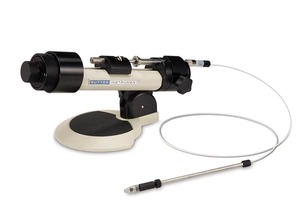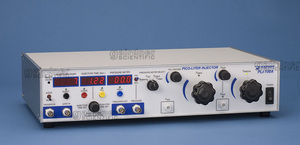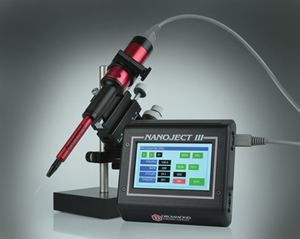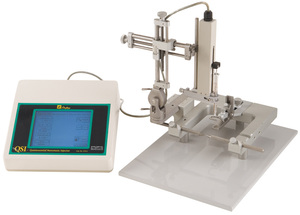Microinjection pump system development background:
A mechanical device for controlling the movement of a microinjection needle within a microscope field under a high-inverted microscope using a micromanipulator for performing microscopic manipulation of cells or early embryos and animal tissues. The latest microinjection technology has been widely extended to animal breeding, endangered species protection, IVF, gene editing, gene knockout, optogenetics research, neural circuit research, nanoparticle capture, engineering microalgae screening, microfluidics Chip technology and other aspects.
The use of glass needles (GlassNeedle, fine glass microcapillary pipettes) based on intracellular microinjection and microperfusion techniques has become a very common method of operation in the field of experimental biology research. For example, in vitro fertilization, transgenic, and the like. The most appropriate description of these techniques should be referred to as micromanipulation because these operations are performed by single or multiple cylindrical glass micropipettes, precision positioning devices (micromanipulators), and microinjectors or A microperfusion device is performed on a single cell.
Microinjection applications range from assisted (in vitro) cell fertilization techniques to the transport of molecular and cellular essential components, typically by injecting certain substances into cells for manipulation and/or Monitor the basic organism biochemical status in a particular viable cell. These substances that can be injected into cells include: various organelles, kinases, histochemical markers (such as horseradish peroxidase or fluorescent yellow), proteins, metabolites, micro-heads, ions, antibodies, genes, molecular biology. mRNA and DNA, etc. Using this technique, it is also possible to achieve precise delivery (microperfusion) of a small amount (picoliter to milliliter) of a medicament or drug for a single cell or group of cells, such as a pharmacological drug test. Transgenic animals can be produced by gene microinjection, embryonic stem cells (ES cells), sperm vector (sperm vector), retroviral vector infection, and somatic cell (somatic cell). Methods such as nucleartransfer) have been achieved, with microinjection being one of the most common methods currently used.
Microinjection is the use of glass microinjection needles with very fine tip (0.1 to 0.5 μm) to directly inject foreign gene fragments into pronuclear embryos or cultured cells, and then may occur through the host genome sequence. The phenomenon of re-rangement, deletion, duplication or translocation causes the foreign gene to be embedded in the chromosome of the host. This microinjection procedure requires fairly precise micromanipulation equipment. When manufacturing long tube tips, a micropipette puller is required. A micromanipulator with a fixed tip position is required for injection. The advantage of this technique is that any DNA can in principle be introduced into any kind of cell. This method has been successfully applied to genetically modified animals including mice, fish, rats, rabbits and many large domestic animals such as cattle, sheep and pigs.
Microinjection pump system function introduction and purchase plan recommendations:
In microinjection technology, the most important one or the device is a microinjection pump, and a set of precision instruments developed from this is called a microinjection pump system. The microinjection pump system mainly includes: microinjection pump main unit, micromanipulator, power source and microinjection needle.
The classification of various microinjection pump systems is mainly based on the microinjection pump mainframe on which the technology relies. Currently, the internationally accepted microinjection pumps are mainly divided into three types; pneumatic pulse-driven air pumps, nanosteps. Motor-controlled electric pump and hydraulically driven manual syringe pump.
1. The hydraulically driven manual syringe pump manually rotates the scale knob by the operator to push forward or withdraw the liquid in the pipeline through the compressed liquid, thereby controlling the sample liquid of the needle tip of the microinjection pump to be injected forward or back into the cell. Substance, etc., due to the certain retardation and compressibility of the liquid pressure, the operator cannot accurately control the injection volume or the suckback amount of the hydraulic type micromanipulator, and the hydraulic manual micromanipulator is pushed forward or sucked back. The pressure is relatively small, and it is not suitable for a large intracellular pressure or a large sucking resistance, and for a microinjection operation requiring precise control of the injection or respiration amount. However, the hydraulically driven manual syringe pump can meet the needs of general laboratory for microinjection operation because of its affordable price. Therefore, for some laboratory users, there are reasons and values ​​for its purchase. The recommended model is as follows: Manual syringe pump.

2. Pneumatically driven microinjection pump system, this series of equipment is connected to the pressure cylinder (usually nitrogen, air, etc.) through the interface of the rear panel of the syringe pump. The main unit sets the pulse "injection" pressure, injection time and glass according to the injection. The needle specification is to accurately inject the sample located in the glass injection needle into the inside of the object to be injected.
The recommended model is a digital display pneumatic lift pump that uses a chip to control the pulse pressure during injection, the injection time, and the specifications of the glass injection needle, such as drugs, nucleic acids, dyes, lentiviruses, neurotransmitters, Gene editing tools, etc.) are precisely injected into the target through a glass injection needle, and the injection volume ranges from pl to ul. Injectables include mammalian cells, fish egg cells (such as zebrafish, barley, squid, etc.) and fish larvae, polyp eggs, nematodes, fruit flies, moths, termites, rodent brain tissue, etc. For genetic research, genetic interference, genetically modified animal breeding, genetic editing, optogenetics research, neural circuit research, reproductive health research, IVF, etc., can also be used for particle capture, such as the selection of target microalgae, nanomaterials Capture of particles, etc. The PLI series digital display picoliter pump includes the following models: PLI-10, PLI-90A, PLI-100A and so on. The PLI-100A has five pressure options such as injection, balance, clearance, filling, and fixation. Parameters such as various pressure values, injection time, and injection operation counts are displayed in real time through the digital display on the front panel.
Advantage: The "balanced" pressure maintains a low positive holding pressure at the tip of the glass injection needle (glass capillary) between each injection pulse to prevent the liquid from being sucked back by capillary siphoning or diffusion (this pressure is for intracellular pressure) Injection operations with larger injectables are particularly beneficial). The "clear" pressure is mainly used to prevent the problem of plugging the tip of the glass needle or to treat the thicker protective film of the injected object, and to perforate the protective film by a suitable pulse. The "filling" pressure is a negative pressure for filling the sample liquid into the glass injection needle. The "fixed" pressure is also a negative pressure, and is mainly used for adsorbing and supporting an object to be injected, such as an egg cell, an insect larva, etc., to prevent the injection from slipping and causing the failure of the microinjection operation.
Insufficient characteristics: 100% of the determined injection volume cannot be achieved because the amount of single injection of the pneumatic syringe pump and the pulse pressure selection at the time of injection, the length of the pulse time, the length of the glass injection needle, the shape and opening size, and the viscosity of the injection solution are all It is related that if the above parameters are not completely consistent, the micro-volumes of the two injections or suctions are different; at the same time, the picoliter syringe pump controlled by the pneumatic pulse requires the operator to have more experienced micromanipulation experience and understand the experiment. The injection volume and injection site required for the injectables are often used for multiple operations, and the reproducible micromanipulation injection data can be achieved, which indirectly affects the experimental efficiency and the success rate of the beginner experiment.
The recommended pneumatic pump for the pneumatic power source on the international market is the digital pneumatic pump, as shown in the figure:

The main application prospects of this series of digital pneumatic skin lift syringe pumps are:
1. Fish genetics research application:
â—Injection of nucleic acid substances, dyes, functional proteins, lentiviruses, etc. for fish egg cells and larvae of zebrafish, barley, Chinese sturgeon, and black spotted larvae;
â— Genetic studies for marine organisms such as polyps;
2. Application of brain science research:
â— Intracranial precise injection of animals for substances such as lentivirus in optogenetics;
â— Intracranial vibration-free precise injection of drugs for drugs, dyes or neurotransmitters in neural circuit research;
â— Brain tissue injections for related research and therapeutic drugs for invading brain tissue such as bacterial toxins and viruses in infection and immunoscience research;
â— Used in neurological drug research, drugs through the blood-brain barrier and other related research;
3. Application of insect research:
â— for injection of nematodes, worms, drugs, nucleic acid substances or dyes;
â—Used for injecting drugs, nucleic acid substances or dyes in vivo, such as fruit fly, cotton bollworm and brown planthopper, involving plant pest control research, insect genetics research, etc.;
4. For injection into the snail, Xenopus egg cells and pups;
5. Research applications of rodents:
â—Injection of drugs, nucleic acid substances, neurotransmitters or dyes for deep tissues in the brain such as rats and test rabbits;
â—Injection of drugs, dyes or other substances in the limb organs or tissues of rats, rabbits and other animals, including inflammation studies, optogenetic studies, etc.;
6. For reproductive medicine research:
â—Used for artificial insemination, IVF and human reproductive health, genetic research on prenatal and postnatal care;
7. For animal breeding improvement, genetic modification and gene editing technology research:
â— Nuclear transplantation or gene editing tool injection of mammalian somatic or egg cells such as pigs, cattle, goats, etc., involving animal breeding, genetic improvement, genetically modified animals, gene editing techniques, etc.;
8. Research on nanomaterial science and microalgae environmental pollution control:
â— For the capture of nanomaterial particles and target microalgae, respectively, involving nanobiomedical materials, nano drug-loading systems and genetic engineering microalgae to control environmental pollution, functional microalgae energy material production.
3. The nanometer stepping motor driven program-controlled microinjection pump system is mainly based on the microscopic control computer. The accurate volume (minimum resolution of 1 pl) required for injection or suckback is set on the microscopic control computer to complete the injection/return. The time required for suction, and the rate at which the operation is automatically completed, only requires the operator to press the start switch or the foot switch, then the set microinjection program will automatically and accurately inject the sample liquid into the target. in.
Nano-Motor-Driven Programmable Microinjection Pumps We recommend the market for mature and stable Nanoject III and QSI systems. The Nanoject III system is the latest generation of programmable microinjection pump system, ideal for quantitative fixed-speed oocytes and animals. Microinjection or aspiration operations of larvae, protozoa, animal brains, and the like. It provides fast, accurate injection or aspiration of any programmed volume of at least 0.6nL, and can inject or pump up to 4200nL of sample solution in one operation. A glass capillary is used during the injection, and the capillary is filled with mineral oil, and most of the mineral oil is pushed out, and then the injection liquid is pumped back to the tip of the glass capillary. For some operation experiments, the injection liquid can be directly filled into the glass capillary or directly injected into the liquid without first filling the mineral oil. The recommended model is shown below:

The main application prospects of NanojectIII are:
1. Application of zebrafish and other fish research:
â— for injection or aspiration of zebrafish and other fish egg genes or dyes;
â— for injection or aspiration in zebrafish and other fish young fish;
2. Application of insect research:
â— for injection or aspiration of egg cells such as nematodes, worms, fruit flies, cotton bollworm, and brown planthopper;
â— for the injection of drugs or dyes in nematodes and worms;
â—Used for drug or dye injection in fruit fly, cotton bollworm and brown planthopper;
3. For injection of Xenopus egg cells and pups;
4. Research applications of rodents:
â— Injection of drugs or neurotransmitters or dyes for deep tissues in the brain such as rats and mice;
â—Used in rat and mouse egg cells and embryonic genetic material, drugs and dye injection.
And we recommend another set of nano stepping motor driven microinjection pump system for ultra-micro special positioning syringe pump. QSI is the latest generation of the best instrument for brain injecting applications. . QSI is the only ultra-micro syringe pump on the market that can achieve a minimum injection volume of 1 pl and an injection flow rate of 0.05 nl/min to 520 ul/min. This type of syringe pump can directly place 0.5ul to 250ul capacity micro-injectors, and match the micro-injector models produced by most manufacturers on the market. Simply select the corresponding information library from the instrument's full-touch microcomputer controller. Syringe brand and specification for precise volume and flow rate injection or suckback operations.
The recommended model QSI is as shown:

The main application prospects of this series of models are:
1. Application of brain science research:
â— Intracranial precise injection of animals for substances such as lentivirus in optogenetics;
• Intracranial precise injection of drugs, dyes or neurotransmitters in neural circuit studies;
â—Research on the invasion of brain tissue by bacterial toxins and viruses in infection and immunoscience research;
â— Used in neurological drug research, drugs through the blood-brain barrier and other related research;
2. Application of insect research:
â— for injection of nematodes, worms, drugs, nucleic acid substances or dyes;
â—Used for the injection of drugs, nucleic acid substances or dyes in fruit flies, cotton bollworm and brown planthopper;
3. For injection of Xenopus egg cells and pups;
4. Research applications of rodents:
â—Injection of drugs, nucleic acid substances, neurotransmitters or dyes for deep tissues in the brain such as rats and mice;
• Injection of micro-damage drugs, dyes or other substances for organs or tissues of rats, mice and other animals.
Regarding the choice of micro-injection pump driven by nano stepping motor, Nanoject III and QSI are both highly automated, easy to use for beginners, easy to operate, accurate in program control, etc., but Nanoject III and QSI function are slightly different, among them QSI The needle directly controlled at the front end is a micro-injector, which is a steel needle injection head, which can inject animal tissue. However, if it is necessary to inject more tiny cells or to avoid damage to living animals, we recommend using hot melt adhesive in front of the steel needle. The upper section of the glass needle needle. The Nanoject III does not require this hot melt transfer operation, because the front end of the syringe pump is equipped with a glass needle that can be used directly.
The experimental personnel of various research institutes should count and predict in advance the samples of the injected samples to be injected before the selection of the microinjection pump system, and how high the precision of microinjection needs to be achieved. The budget of the laboratory is the amount of the experimental operator's technical level, as well as the subsequent maintenance costs of the equipment, space occupancy, equipment utilization, etc., choose the best microinjection pump system option.
White Sesame Oil,Ground Sesame Seed Oil,White Sesame Seed Oil,A Grade Sesame Oil
Chinese Seasoning (Shandong) Trading Co.,Ltd , https://www.zt-trading.com